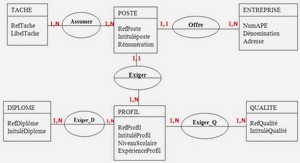The global mobile data traffic is growing exponentially due to the emergence of new wireless devices and applications. The mobile data traffic is various and composed of: video, web, games, VoIP, mobile to mobile and file sharing. Moreover, according to some projections, the number of connected devices may reach 50 billion in the next decade Gupta & Jha (2015). Hence, the design of new systems that support this large number of wireless devices is vital. In particular, these systems must support the traffic of the data exchanged while taking into account the energy efficiency of the proposed solutions. The challenge of designing future generations of cellular networks is to support the exponential increase in mobile data traffic. The researchers are in the process of designing the 5th generation (5G) cellular networks. Several guidelines are established to evolve 4G. Thus, some technologies will be adopted in the design of 5G cellular networks.
A powerful strategy is to adopt large-scale multiple-input multipleoutput (MIMO) systems (also known as massive MIMO) in 5G cellular networks Gupta & Jha (2015); Boccardi et al. (2014); Nam et al. (2013); Andrews et al. (2014); Larsson et al. (2014); Zheng et al. (2015); Yang & Hanzo (2015) which is the focus of this dissertation.
Large-Scale MIMO Systems for Next Generation Wireless Networks
Large-scale MIMO is based on using few hundreds of antennas simultaneously to serve tens of users in the same time-frequency resource. The diversity of large number of antennas implies quasi-orthogonality between the users’ channels in consequence of the law of large numbers. Hence, linear transmitters and receivers based on spatial multiplexing achieve high performance Boccardi et al. (2014). The benefits of large-scale MIMO systems are summarized in Gupta & Jha (2015); Zheng et al. (2015):
• Enhance the spectral efficiency and the energy efficiency.
• Implement low power and low cost RF chains.
• Reduce the latency.
• Simplify the access layer.
Now, we discuss the impact of large-scale antenna systems compared to conventional MIMO systems Gupta & Jha (2015). First, large-scale MIMO systems inherit the benefits of conventional MIMO systems. The introduction of a large number of antennas implies a quasiorthogonality of the channels. Thus, maximum ratio transmission (MRT) and maximum ratio combiner receiver (MRC) are suitable as transmit and receive techniques while its performances are limited for conventional MIMO systems. In addition, the channel is no longer frequency selective. The transmission can be done on the same time-frequency resources. The increase in the number of transmit antennas requires more resources but the consumed power per antenna decreases. Thus, we may deploy low power RF chains with reduced complexity. On the other hand, deploying all the antennas on the same base station is practically difficult and distributed antenna systems are required. Channel estimation is very challenging in largescale MIMO systems. In conventional MIMO systems, the base station sends pilot symbols to users. Users estimate the channels and send the estimated channel coefficients to the base station. This is no longer feasible for large-scale MIMO systems due to the large number of antennas that will result in an increase of the size of control packets and the dominance of pilot contamination impact. Existing solutions of resource allocation in conventional MIMO systems become complex for a large number of antennas. Also, as the number of antennas becomes large, the power consumed by the circuit of RF chains is no longer neglected. Therefore, the consumed circuit power must be taken into consideration when optimizing system performance.
In Andrews et al. (2014), the authors confirm that large-scale MIMO systems achieve the primary goal of 5G, which is the increase of the throughput. In addition, it can coexist with other 5G technologies especially mmWave systems and heterogeneous networks. Thus, the investigation of new interference management scheme is vital. Larsson et al. (2014) presents largescale MIMO technology as a potential candidate for interconnecting Internet of Things systems since it reduce the latency. Furthermore, large-scale MIMO systems provide excellent performance with low complexity transmit and receive systems Rusek et al. (2013); Yang & Marzetta (2013); Ngo et al. (2013b). In Pitarokoilis et al. (2012), the authors show that spatial multiplexing in large-scale MIMO systems allows to obtain a uniform channel gain coefficient. Thus, this technology eliminates the frequency selectivity of the propagation channel. Therefore, the transmission of data symbols can be done on a single carrier with near-optimal performance. Thus, this technique allows to considerably simplify the media access control layer.
The deployment of a large number of antennas at the same base station is challenging in practice, although this deployment offers the best performance. In Nam et al. (2013), the authors propose to deploy the antennas in a 3 diemntionnal grid and they modeled the propagation channel geometrically by a spatial channel model for several antenna configurations. New architectures based on a distributed deployment of the antennas have to be investigated. In Wang et al. (2014), the authors investigated the architectures and technologies of cellular networks that can be adopted in 5G. Specifically, they considered that large-scale MIMO systems could be implemented in a distributed way, antennas will be deployed on several transmit devices in order to improve the spectral efficiency and energy efficiency with simple linear precoder.
The channel estimation in large-scale MIMO systems is usually done in time division duplex (TDD). Based on channel reciprocity, the channel gains are assumed to be the same at uplink and downlink. As a result, channel estimation proceeds by sending pilot symbols from users to the base station on uplink. Furthermore, since the number of orthogonal pilot symbol sequences is limited, there will be a reuse of the same pilot symbols in the adjacent cells. This generates an interference phenomenon between pilot symbols called pilot contamination, specially when the number of antennas is large. Overcoming this problem is challenging and is the subject of several research works Jose et al. (2011); Ngo et al. (2013a). Also, channel estimation in frequency division duplex (FDD) large-scale MIMO systems is very challenging.
INTRODUCTION |






